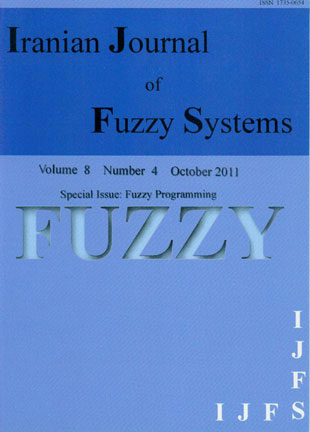فهرست مطالب

Iranian journal of fuzzy systems
Volume:8 Issue: 4, Oct 2011
- Special Issue: Fuzzy Programming
- تاریخ انتشار: 1390/08/22
- تعداد عناوین: 8
-
-
Page 0
-
Page 1Convexity theory and duality theory are important issues in math- ematical programming. Within the framework of credibility theory, this paper rst introduces the concept of convex fuzzy variables and some basic criteria. Furthermore, a convexity theorem for fuzzy chance constrained programming is proved by adding some convexity conditions on the objective and constraint functions. Finally, a duality theorem for fuzzy linear chance constrained pro- gramming is proved.
-
Page 9We consider biobjective shortest path problems in networks with fuzzy arc lengths. Considering the available studies for single objective shortest path problems in fuzzy networks, using a distance function for comparison of fuzzy numbers, we propose three approaches for solving the biobjective prob- lems. The rst and second approaches are extensions of the labeling method to solve the single objective problem and the third approach is based on dynamic programming. The labeling methods usually producing several nondominated paths, we propose a fuzzy number ranking method to determine a fuzzy short- est path. Illustrative examples are worked out to show the e ectiveness of our algorithms.
-
Page 39The railway transportation planning under the fuzzy environment is investigated in this paper. As a main result, a new modeling method, called minimum risk chance-constrained model, is presented based on the credibility measure. For the convenience ofs olving the mathematical model, the crisp equivalents ofc hance functions are analyzed under the condition that the involved fuzzy parameters are trapezoidal fuzzy variables. An approximate model is also constructed for the problem based on an improved discretization method for fuzzy variables and the relevant convergence theorems. To obtain an approximate solution, a tabu search algorithm is designed for the presented model. Finally, some numerical experiments are performed to show the applications ofthe model and the algorithm.
-
Page 61In this paper, we consider portfolio selection problem in which security returns are regarded as fuzzy variables rather than random variables. We first introduce a concept of absolute deviation for fuzzy variables and prove some useful properties, which imply that absolute deviation may be used to measure risk well. Then we propose two mean-absolute deviation models by defining risk as absolute deviation to search for optimal portfolios. Furthermore, we design a hybrid intelligent algorithm by integrating genetic algorithm and fuzzy simulation to solve the proposed models. Finally, we illustrate this approach with two numerical examples.
-
Page 77Train energy saving problem investigates how to control train''s velocity such that the quantity of energy consumption is minimized and some system constraints are satis ed. On the assumption that the train''s weights on di erent links are estimated by fuzzy variables when making the train scheduling strategy, we study the fuzzy train energy saving problem. First, we propose a fuzzy energy consumption minimization model, which minimizes the average value and entropy of the fuzzy energy consumption under the maximal allowable velocity constraint and traversing time constraint. Furthermore, we analyze the properties of the optimal solution, and then design an iterative algorithm based on the Karush-Kuhn-Tucker conditions. Finally, we illustrate a numerical example to show the e ectiveness of the proposed model and algorithm.
-
Page 93Although many methods exist for intensity modulated radiotherapy (IMRT) fluence map optimization for crisp data, based on clinical practice, some of the involved parameters are fuzzy. In this paper, the best fluence maps for an IMRT procedure were identifed as a solution of an optimization problem with a quadratic objective function, where the prescribed target dose vector was fuzzy. First, a defuzzying procedure was introduced to change the fuzzy model of the problem into an equivalent non-fuzzy one. Since the solution set was nonconvex, the optimal solution was then obtained by performing a projection operation in applying the gradient method. Numerical simulations for two typical clinical cases (for prostate and head-and-neck cancers, each for two patients) are given.
-
Page 107Coalitional game deals with situations that involve cooperations among players, and there are di erent solution concepts such as the core, the Shapley value and the kernel. In many situations, there is no way to predict the payo functions except for the expert experiences and subjective intuitions, which leads to the coalitional game with fuzzy payo s. Within the framework of credibility theory, this paper employs two credibilistic approaches to de ne the behaviors of players under fuzzy situations. Correspondingly, two variations of Shapley value are proposed as the solutions of the coalitional game with fuzzy payo s. Meanwhile, some characterizations of the credibilistic Shapley value are investigated. Finally, an example is provided for illustrating the usefulness of the theory developed in this paper.

